Sir John Monash, Personal Files Book 6, 10 June - 12 July 1915, Part 16
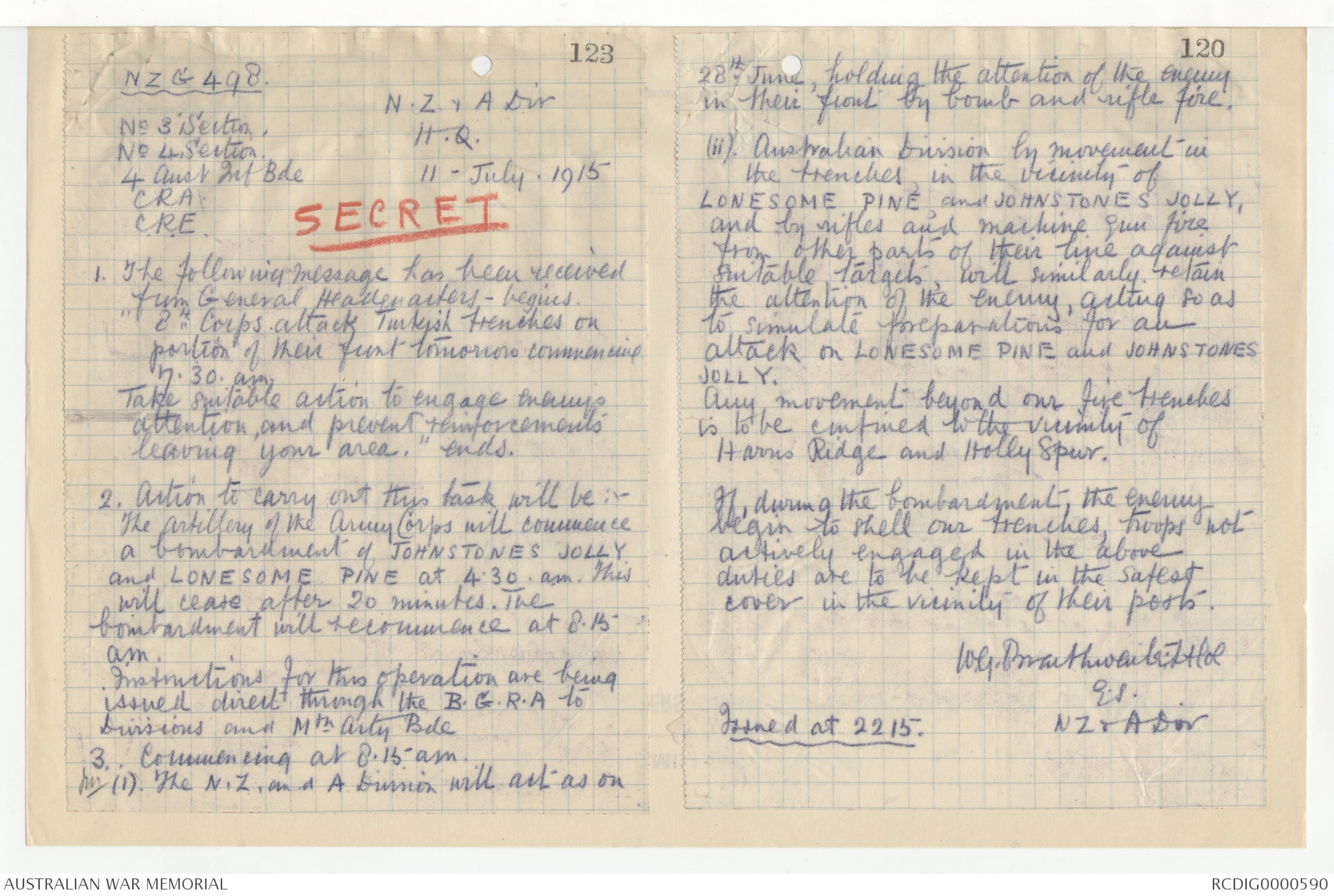
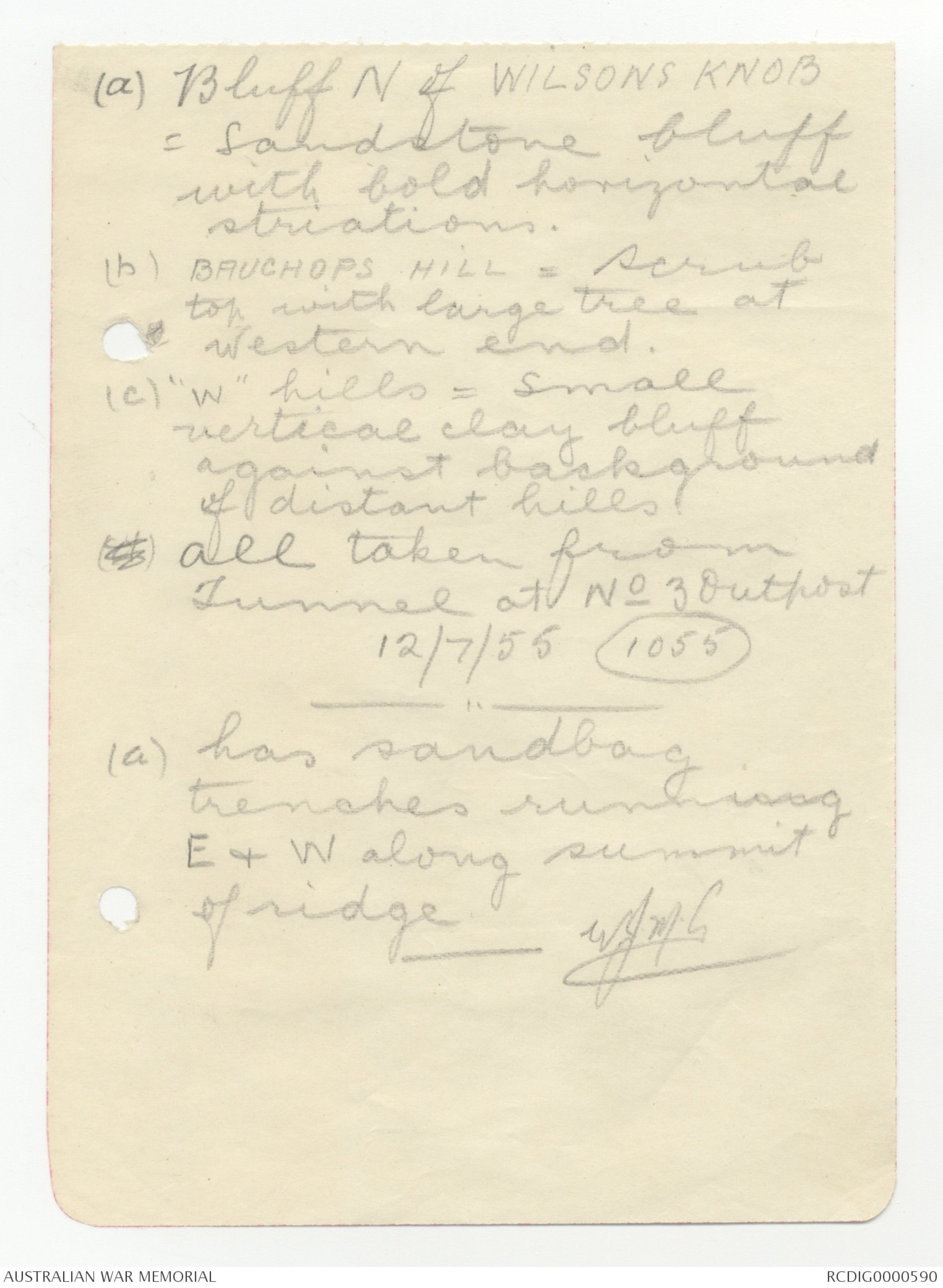
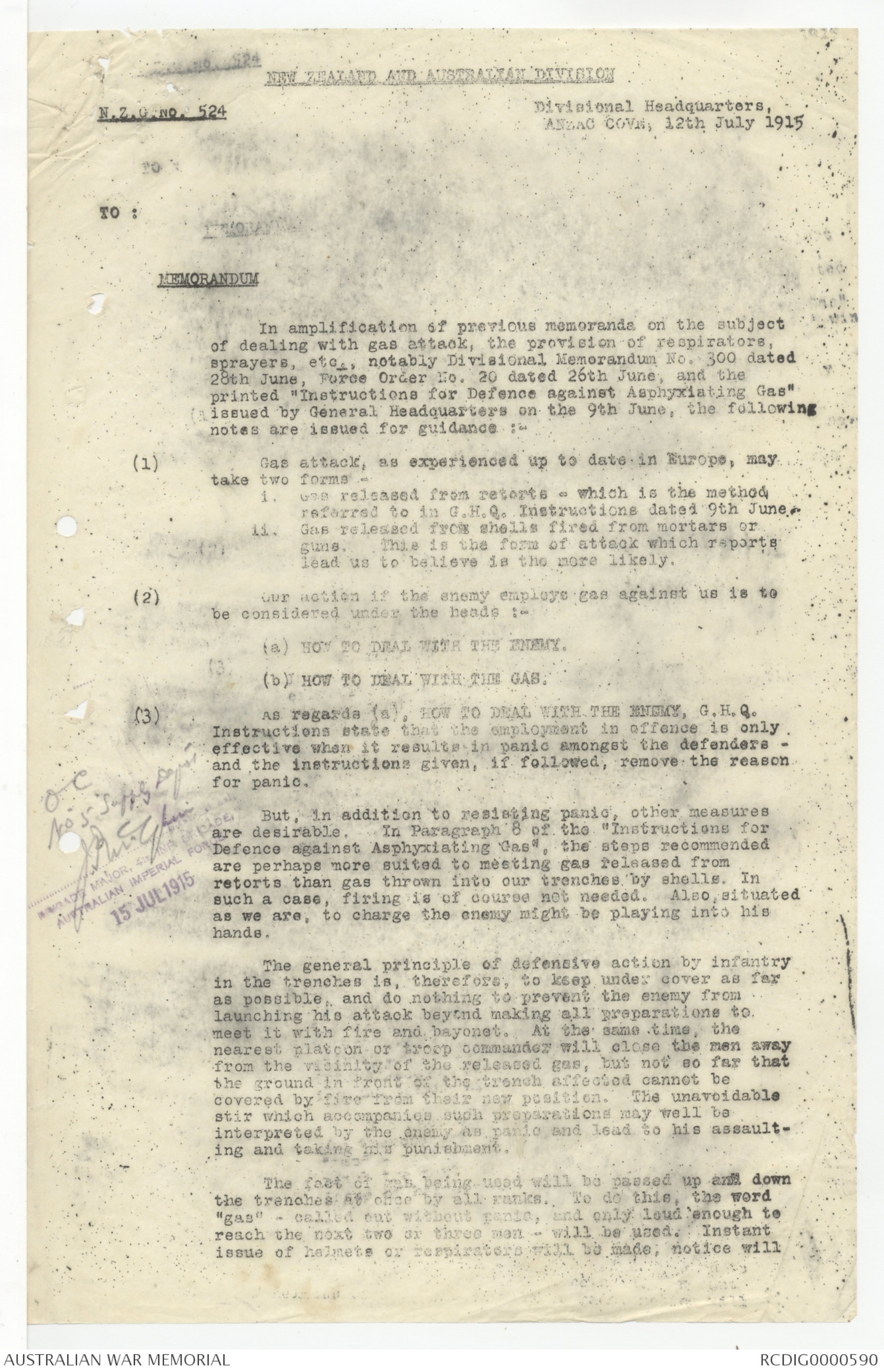
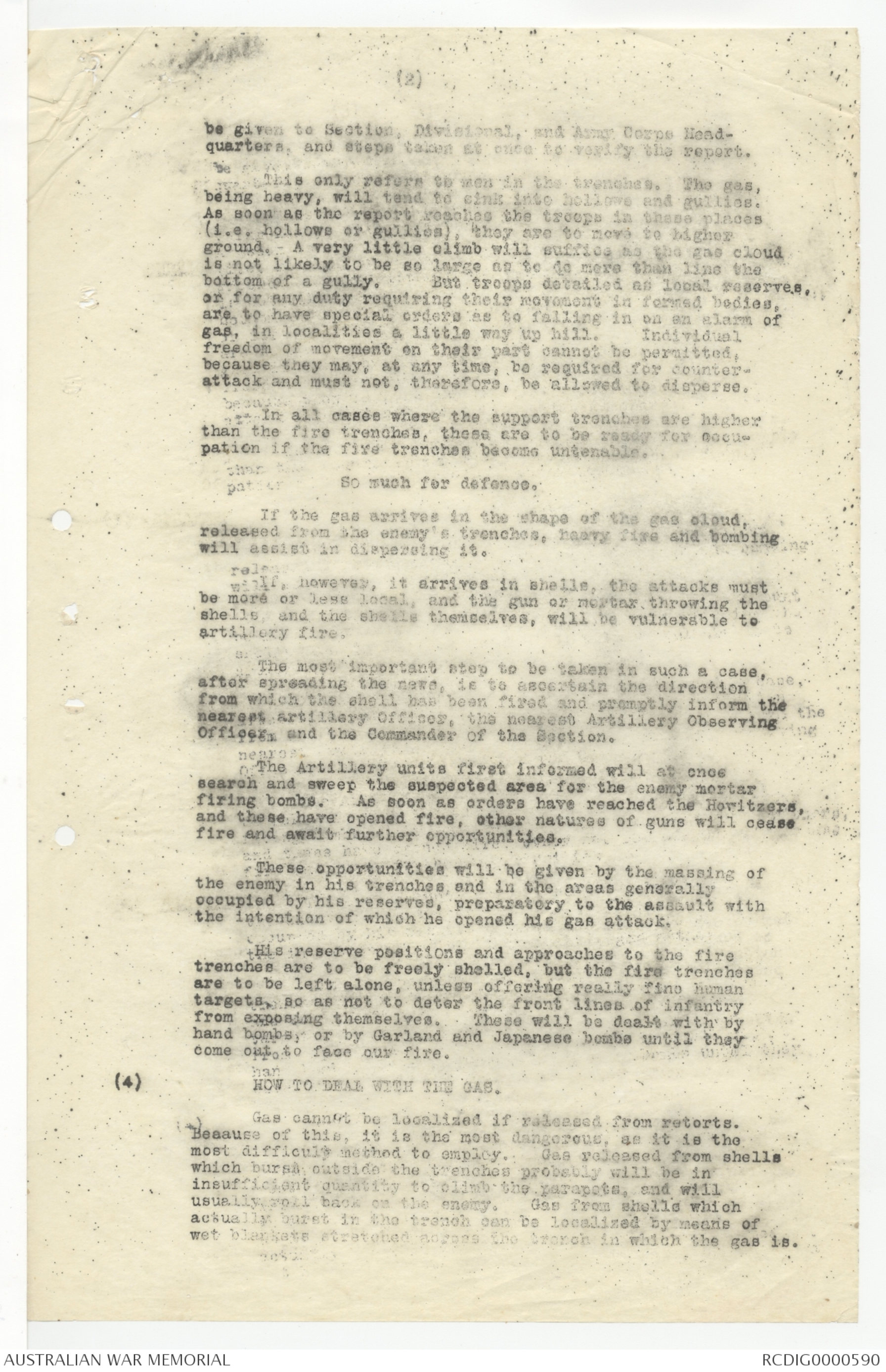
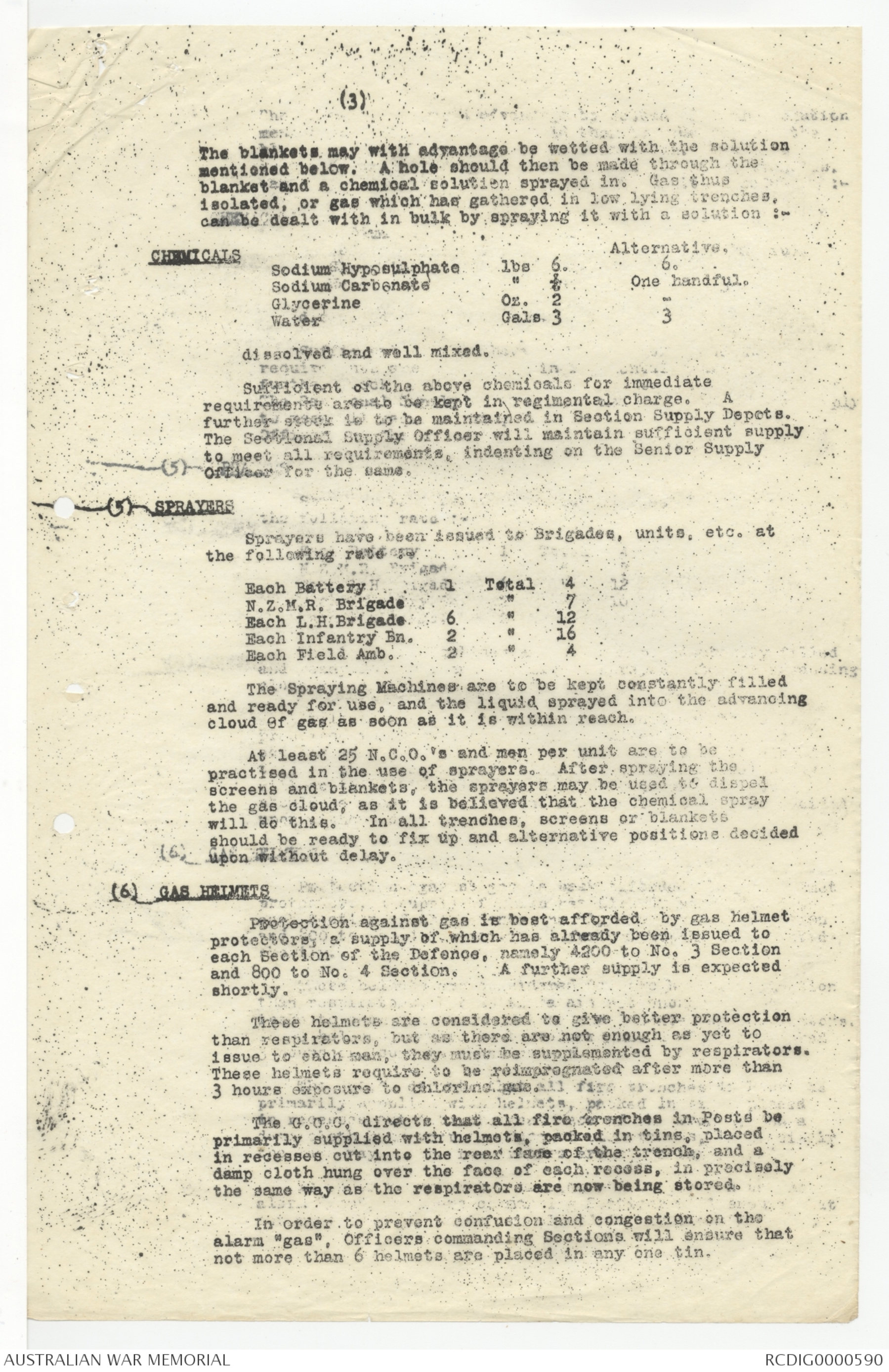
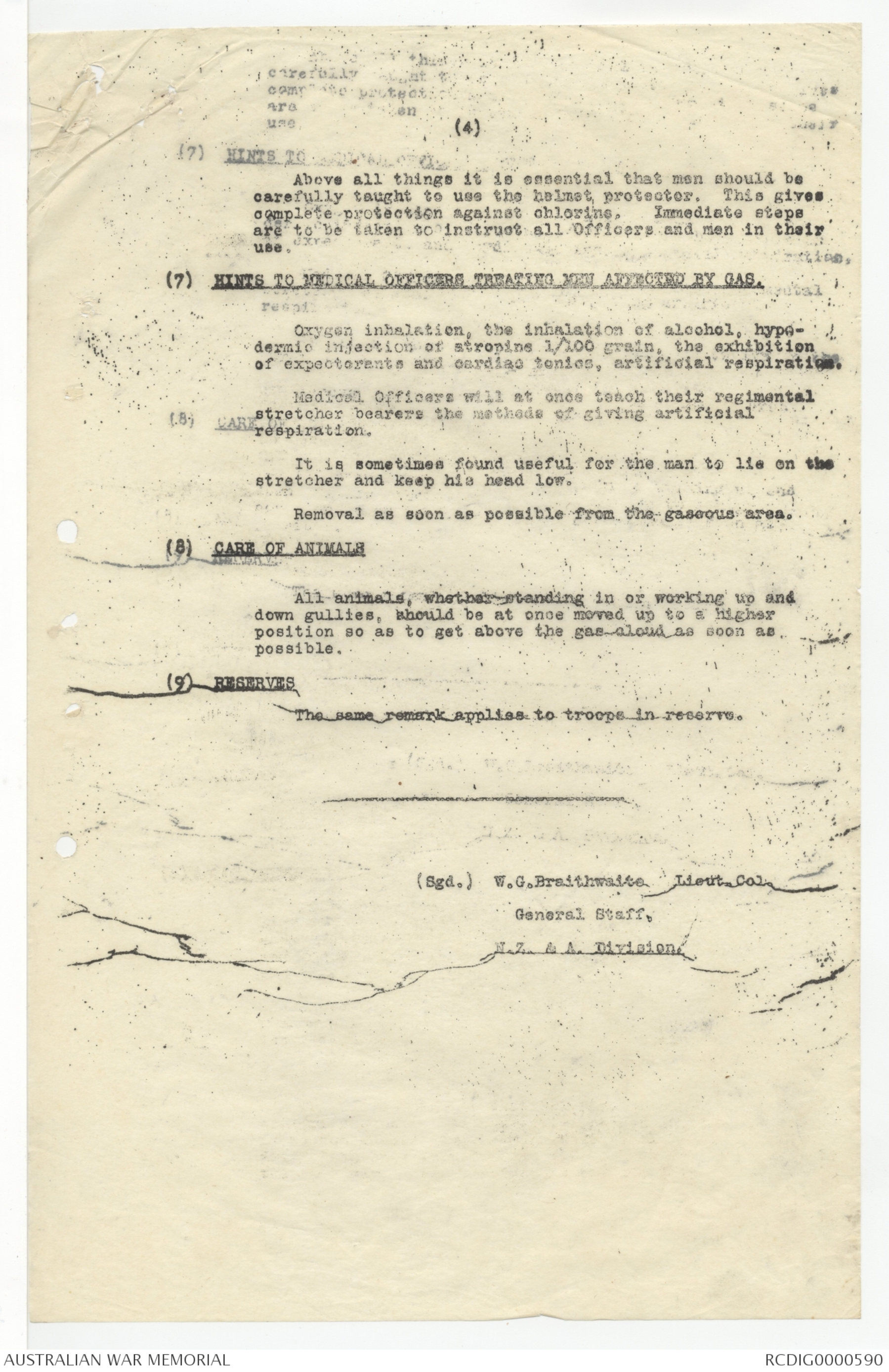
123
NZG 498.
N.Z. & A Div
H.Q.
11 - July. 1915
No 3 Section,
No 4 Section,
4 Aust Inf Bde
CRA
C.R.E.
SECRET
1. The following message has been received
from General Headquarters - begins.
"8th Corps attack Turkish trenches on
portion of their front tomorrow commencing
7.30. am.
Take suitable action to engage enemy
attention, and prevent reinforcements
leaving your area." ends.
2. Action to carry out this task will be:-
The artillery of the Army Corps will commence
a bombardment of JOHNSTONES JOLLY
and LONESOME PINE at 4.30. am. This
will cease after 20 minutes. The
bombardment will recommence at
8.15 am.
Instructions for this operation are being
issued direct through the B.G.R.A to
Divisions and Mtn Arty Bde
3. Commencing at 8.15 am.
(*JM*) (i) The N.Z. and A Division will act as on
120
28th June, holding the attention of the enemy
in their front by bomb and rifle fire.
(ii) Australian Division by movement in
the trenches in the vicinity of
LONESOME PINE, and JOHNSTONES JOLLY,
and by rifles and machine gun fire
from other parts of their line against
suitable targets, will similarly retain
the attention of the enemy, acting so as
to simulate preparations for an
attack on LONESOME PINE and JOHNSTONES
JOLLY.
Any movement beyond our fire trenches
is to be confined to the vicinity of
Harris Ridge and Holly Spur.
If, during the bombardment, the enemy
begin to shell our trenches, troops
not actively engaged in the above
duties are to be kept in the safest
cover in the vicinity of their posts.
WG Braithwaite Lt Col
G.S.
NZ & A Div
Issued at 2215.
(a) Bluff N of WILSONS KNOB
= Sandstone bluff
with bold horizontal
striations.
(b) BAUCHOPS HILL = Scrub
top with large tree at
Western end.
(c) "W" hills = Small
vertical clay bluff
against background
of distant hills.(d) All taken from
Tunnel at No 3 Outpost
12/7/55 1055
____________
(a) has sandbag
trenches running
E & W along summit
of ridge
____________
WJMG
NEW ZEALAND AND AUSTRALIAN DIVISION
N.Z.G.No. 524
Divisional Headquarters,
ANZAC COVE, 12th July 1915
TO :
MEMORANDUM
In amplification of previous memoranda on the subject
of dealing with gas attack, the provision of respirators,
sprayers, etc., notably Divisional Memorandum No. 300 dated
28th June, Force Order No. 20 dated 26th June, and the
printed "Instructions for Defence against Asphyxiating Gas"
issued by General Headquarters on the 9th June, the following
notes are issued for guidance :-
(1) Gas attack, as experienced up to date in Europe, may
take two forms -
i. Gas released from retorts - which is the method
referred to in G.H.Q. Instructions dated 9th June.
ii. Gas released from shells fired from mortars
or guns. This is the form of attack which reports
lead us to believe is the more likely.
(2) Our action if the enemy employs gas against us is to
be considered under the heads :-
(a) HOW TO DEAL WITH THE ENEMY.
(b) HOW TO DEAL WITH THE GAS.
(3) As regards (a), HOW TO DEAL WITH THE ENEMY, G.H.Q.
Instructions state that the employment in offence is only
effective when it results in panic amongst the defenders -
and the instructions given, if followed, remove the reason
for panic.
But, in addition to resisting panic, other measures
are desirable. In Paragraph 8 of the "Instructions for
Defence against Asphyxiating Gas", the steps recommended
are perhaps more suited to meeting gas released from
retorts than gas thrown into our trenches by shells. In
such a case, firing is of course not needed. Also, situated
as we are, to charge the enemy might be playing into his
hands.
The general principle of defensive action by infantry
in the trenches is, therefore, to keep under cover as far
as possible, and do nothing to prevent the enemy from
launching his attack beyond making all preparations to
meet it with fire and bayonet. At the same time,
the nearest platoon or troop commander will close the men away
from the vicinity of the released gas, but not so far that
the ground in front of the trench affected cannot be
covered by fire from their new position. The unavoidable
stir which accompanies such preparations may well be
interpreted by the enemy as panic and lead to his assaulting
and taking his punishment.
The fact of gas being used will be passed up and down
the trenches at once by all ranks. To do this, the word
"gas" - called out without panic, and only loud enough to
reach the next two or three men - will be used. Instant
issue of helmets or respirators will be made; notice will
(2)
be given to Section, Divisional, and Army Corps Headquarters,
and steps taken at once to verify the report.
This only refers to men in the trenches. The gas,
being heavy, will tend to sink into hollows and gullies.
As soon as the report reaches the troops in these places
(i.e. hollows or gullies), they are to move to higher
ground. A very little climb will suffice as the gas cloud
is not likely be so large as to do more than line the
bottom of a gully. But troops detailed as local reserves,
or for any duty requiring their movement in formed bodies,
are to have special orders as to falling in on an alarm of
gas, in localities a little way up the hill. Individual
freedom of movement on their part cannot be permitted,
because they may, at any time, be required for counter-attack
and must not, therefore, be allowed to disperse.
In all cases where the support trenches are higher
than the fire trenches, these are to be ready for occupation
if the fire trenches become untenable.
So much for defence.
If the gas arrives in the shape of the gas cloud,
released from the enemy's trenches, heavy fire and bombing
will assist in dispersing it.
If, however, it arrives in shells, the attacks must
be more or less local, and the gun or mortar throwing the
shells, and the shells themselves, will be vulnerable to
artillery fire.
The most important step to be taken in such a case,
after spreading the news, is to ascertain the direction
from which the shell has been fired and promptly inform the
nearest artillery officer, the nearest Artillery Observing
Officer, and the Commmander of the Section.
The Artillery units first informed will at once
search and sweep the suspected area for the enemy mortar
firing bombs. As soon as orders have reached the Howitzers,
and these have opened fire, other natures of guns will cease
fire and await further opportunities.
These opportunities will be given by the massing of
the enemy in his trenches and in the areas generally
occupied by his reserves, preparatory to the assault
with the intention of which he opened his gas attack.
His reserve positions and approaches to the fire
trenches are to be freely shelled, but the fire trenches
are to be left alone, unless offering really fine human
targets, so as not to deter the front lines of infantry
from exposing themselves. These will be dealt with by
hand bombs, or by Garland and and Japanese bombs until
they come out to face our fire.
(4) HOW TO DEAL WITH THE GAS.
Gas cannot be localized if released from retorts.
Because of this, it is the most dangerous, as it is the
most difficult method to employ. Gas released from shells
which burst outside the trenches probably will be in
insufficient quantity to climb the parapets, and will
usually roll back on the enemy. Gas from shells which
actually burst in the trench can be localized by means of
wet blankets stretched across the trench in which the gas is.
(3)
The blankets may with advantage be wetted with the solution
mentioned below. A hole should then be made through the
blanket and a chemical solution sprayed in. Gas thus
isolated, or gas which has gathered in low lying trenches,
can be dealt with in bulk by spraying it with a solution :-
CHEMICALS Alternative
Sodium Hyposulphate 1bs 6. 6.
Sodium Carbonate " ¼ One handful.
Glycerine Oz. 2 -
Water Gals. 3 3
dissolved and well mixed.
Sufficient of the above chemicals for immediate
requirements are to be kept in regimental charge. A
further stock is to be maintained in Section Supply Depots.
The Sectional Supply Officer will maintain sufficient supply
to meet all requirements, indenting on the Senior Supply
Officer for the same.
(5) SPRAYERS
Sprayers have been issued to Brigades, units, etc. at
the following rate :-
Each Battery 1 Total 4
N.Z.M.R. Brigade " 7
Each L.H. Brigade 6 " 12
Each Infantry Bn. 2 " 16
Each Field Amb. 2 " 4
The Spraying Machines are to be kept constantly filled
and ready for use, and the liquid sprayed into the advancing
cloud of gas as soon as it is within reach.
At least 25 N.C.O.'s and men per unit are to be
practised in the use of sprayers. After spraying the
screens and blankets, the sprayers may be used to dispel
the gas cloud, as it is believed that the chemical spray
will do this. In all trenches, screens or blankets
should be ready to fix up and alternative positions decided
upon without delay.
(6) GAS HELMETS
Protection against gas is best afforded by gas helmet
protectors, a supply of which has already been issued to
each Section of the Defence, namely 4200 to No. 3 Section
and 800 to No. 4 Section. A further supply is expected
shortly.
These helmets are considered to give better protection
than respirators, but as there are not enough as yet to
issue to each man, they must be supplemented by respirators.
These helmets require to be reimpregnated after more than
3 hours exposure to chlorine gas.
The G.O.C. directs that all fire trenches in Posts be
primarily supplied with helmets, packed in tins, placed
in recesses cut into the rear face of the trench, and a
damp cloth hung over the face of each recess, in precisely
the same way as the respirators are now being stored.
In order to prevent confusion and congestion on the
alarm "gas", Officers commanding Sections will ensure that
not more than 6 helmets are placed in any one tin.
(4)
Above all things it is essential that men should be
carefully taught to use the helmet protector. This gives
complete protection against chlorine. Immediate steps
are to be taken to instruct all Officers and men in their
use.
(7) HINTS TO MEDICAL OFFICERS TREATING MEN AFFECTED BY GAS.
Oxygen inhalation, the inhalation of alcohol, hypodermic
injection of atropine 1/100 grain, the exhibition
of expectorants and cardiac tonics, artificial respiration.
Medical Officers will at once teach their regimental
stretcher bearers the methods of giving artificial
respiration.
It is sometimes found useful for the man to lie on the
stretcher and keep his head low.
Removal as soon as possible from the gaseous area.
(8) CARE OF ANIMALS
All animals, whether standing in or working up and
down gullies, should be at once moved up to a higher
position so as to get above the gas cloud as soon as
possible.
(9) RESERVES
The same remark applies to troops in reserve.
(Sgd.) W.G.Braithwaite, Lieut. Col.
General Staff,
N.Z. & A. Division
 Jacqueline Kennedy
Jacqueline KennedyThis transcription item is now locked to you for editing. To release the lock either Save your changes or Cancel.
This lock will be automatically released after 60 minutes of inactivity.